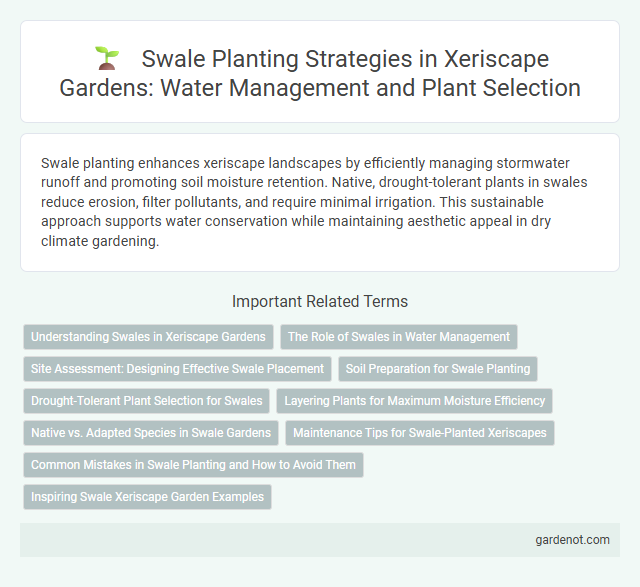Swale planting enhances xeriscape landscapes by efficiently managing stormwater runoff and promoting soil moisture retention. Native, drought-tolerant plants in swales reduce erosion, filter pollutants, and require minimal irrigation. This sustainable approach supports water conservation while maintaining aesthetic appeal in dry climate gardening.
Understanding Swales in Xeriscape Gardens
Swales in xeriscape gardens function as shallow, vegetated channels designed to capture and infiltrate stormwater, reducing runoff and promoting groundwater recharge. Planting in swales includes drought-tolerant native grasses, sedges, and deep-rooted perennials that stabilize soil while enhancing water absorption. Effective swale vegetation selection improves erosion control, supports local biodiversity, and maintains soil moisture in arid landscapes.
The Role of Swales in Water Management
Swales play a critical role in xeriscaping by capturing and directing stormwater runoff, reducing soil erosion, and enhancing groundwater recharge. Strategically planted with native drought-tolerant vegetation, swales improve water infiltration and minimize the need for supplemental irrigation. This sustainable water management practice supports resilient landscapes by conserving water and promoting healthy soil ecosystems.
Site Assessment: Designing Effective Swale Placement
Site assessment for swale planting involves analyzing topography, soil composition, and water flow patterns to determine optimal placement. Identifying natural drainage routes and areas prone to erosion ensures swales maximize water capture and infiltration. Precise evaluation of slope gradient and soil permeability supports designing swales that reduce runoff and promote sustainable xeriscape irrigation.
Soil Preparation for Swale Planting
Swale planting requires meticulous soil preparation to maximize water retention and infiltration, focusing on loosening compacted soils and incorporating organic matter such as compost to improve soil structure. Amending the soil with mulch and native soil microbes enhances nutrient availability and promotes healthy root development for drought-tolerant plants. Proper grading and contouring ensure effective water flow into the swale, reducing erosion and supporting sustainable xeriscape landscaping.
Drought-Tolerant Plant Selection for Swales
Drought-tolerant plants for swales are critical in xeriscape landscaping, enhancing water efficiency and soil stabilization. Native grasses, succulents like sedum, and deep-rooted perennials such as purple coneflower and yarrow thrive under minimal irrigation, reducing water consumption. Selecting plants with high drought resilience improves swale function by promoting infiltration, preventing erosion, and supporting local biodiversity.
Layering Plants for Maximum Moisture Efficiency
Swale planting enhances water retention by strategically layering plants with varying root depths to maximize moisture absorption in xeriscape landscapes. Deep-rooted trees or shrubs capture and store water from swales, while mid and shallow-rooted perennials and groundcovers efficiently utilize surface moisture. This multi-tiered vegetation approach optimizes soil hydration, reduces evaporation, and promotes sustainable water management in arid environments.
Native vs. Adapted Species in Swale Gardens
Swale planting in xeriscape gardens thrives when native species are prioritized due to their deep-rooted adaptation to local climate and soil conditions, enhancing water retention and reducing maintenance. Adapted species can complement native plants by providing additional diversity and resilience but may require more water and care. Selecting native plants like sedges, rushes, and local wildflowers ensures ecological balance while supporting native wildlife in swale gardens.
Maintenance Tips for Swale-Planted Xeriscapes
Swale-planted xeriscapes require minimal watering, relying on drought-tolerant plants like native grasses and succulents to thrive. Regular inspections for erosion and sediment buildup maintain proper water flow and prevent runoff damage. Seasonal pruning and mulching help retain soil moisture and reduce weed competition in swale environments.
Common Mistakes in Swale Planting and How to Avoid Them
Common mistakes in swale planting include improper plant selection, poor soil preparation, and inadequate spacing, which can lead to erosion and waterlogging. Choosing native, drought-tolerant species and amending soil with organic matter promotes healthy growth and efficient water absorption. Properly spacing plants based on mature size and ensuring a gradual slope in the swale design prevent stagnant water and root rot.
Inspiring Swale Xeriscape Garden Examples
Swale planting in xeriscape gardens showcases drought-tolerant species such as native grasses, succulents, and deep-rooted perennials that enhance water absorption and soil stabilization. Examples like the Tucson Xeriscape Garden feature carefully selected plants like Agave americana and Muhlenbergia rigens that thrive in arid conditions while reducing irrigation needs. These inspiring swale designs improve rainwater harvesting efficiency and demonstrate sustainable landscaping tailored for dry climates.
Swale planting Infographic

 gardenot.com
gardenot.com